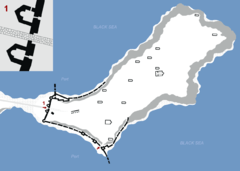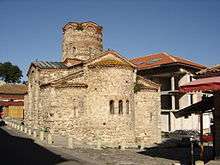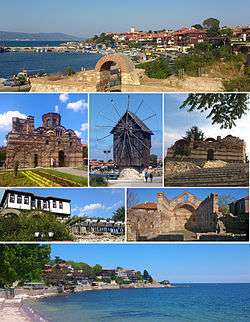Nesebar
| Nessebar Несебър | |
|---|---|
| Town | |
|
From top left: Northern harbour, Church of Christ Pantokrator, The wooden windmill on the isthmus, Church of St John Aliturgetos, Old house and town walls, Church of St Sophia, Southern bay of the old town | |
 Nessebar Position of Nesebar in Bulgaria | |
| Coordinates: 42°39′N 27°44′E / 42.650°N 27.733°ECoordinates: 42°39′N 27°44′E / 42.650°N 27.733°E | |
| Country | Bulgaria |
| Province | Burgas |
| Government | |
| • Mayor | Nikolay Dimitrov |
| Area | |
| • Town | 31.852 km2 (12.298 sq mi) |
| Elevation | 30 m (100 ft) |
| Population (15.12.2010) | |
| • Town | 13,347 |
| • Metro | 28,957 |
| Time zone | EET (UTC+2) |
| • Summer (DST) | EEST (UTC+3) |
| Postal code | 8230 |
| Area code(s) | 0554 |
| UNESCO World Heritage Site | |
| Criteria |
Cultural: (iii), (iv) |
| Reference | 217 |
| Inscription | 1983 (7th Session) |
Nesebar (often transcribed as Nessebar and sometimes as Nesebur, Bulgarian: Несебър, pronounced [nɛˈsɛbɐr], Thracian: Melsambria, Greek: Μεσημβρία, Mesembria) is an ancient city and one of the major seaside resorts on the Bulgarian Black Sea Coast, located in Burgas Province. It is the administrative centre of the homonymous Nesebar Municipality. Often referred to as the "Pearl of the Black Sea", Nesebar is a rich city-museum defined by more than three millennia of ever-changing history. The small city exists in two parts separated a narrow man-made isthmus with the ancient part of the settlement on the peninsula (previously an island), and the more modern section on the mainland side (i.e. hotels, later development). The older part bears evidence of occupation by a variety of different civilisations over the course of its existence.
It is one of the most prominent tourist destinations and seaports on the Black Sea, in what has become a popular area with several large resorts—the largest, Sunny Beach, is situated immediately to the north of Nesebar.
Nesebar has on several occasions found itself on the frontier of a threatened empire, and as such it is a town with a rich history. Due to the city's abundance of historic buildings, UNESCO came to include Nesebar in its list of World Heritage Sites in 1983.
As of December 2009, the town has a population of 11,626 inhabitants.[2]
Name
The settlement was known in Greek as Mesembria (Greek: Μεσήμβρια), sometimes mentioned as Mesambria or Melsembria, the latter meaning the city of Melsas.[3] According to a reconstruction the name might derive from Thracian Melsambria.[4] Nevertheless, the Thracian origin of that name seems to be doubtful. Moreover, the tradition pertaining to Melsas, as founder of the city is tenuous and belongs to a cycle of etymological legends abundant among Greek cities. It also appears that the story of Melsas was a latter reconstruction of the Hellenistic era, when Mesembria was an important coastal city.[5]
History

Bulgarian archaeologist Lyuba Ognenova-Marinova led six underwater archaeological expeditions for the Bulgarian Academy of Sciences (BAS) between 1961 and 1972[6][7] in the waters along the Bulgarian Black Sea Coast. Her work led to the identification of five chronological periods of urbanization on the peninsula surrounding Nesebar through the end of the second millennium B.C., which included the Thracian protopolis, the Greek colony Mesambria, a Roman-ruled village to the Early Christian Era, the Medieval settlement and a Renaissance era town, known as Mesemvria or Nessebar.[6]
Antiquity
Originally a Thracian settlement, known as Menebria, the town became a Greek colony when settled by Dorians from Megara at the beginning of the 6th century BC, and was an important trading centre from then on and a rival of Apollonia (Sozopol). It remained the only Dorian colony along the Black Sea coast, as the rest were typical Ionian colonies. At 425-424 BC the town joined the Delian League, under the leadership of Athens.[8] Remains from the Hellenistic period include the acropolis, a temple of Apollo, and an agora. A wall which formed part of the fortifications can still be seen on the north side of the peninsula. Bronze and silver coins were minted in the city since the 5th century BC and gold coins since the 3rd century BC. The town fell under Roman rule in 71 BC, yet continued to enjoy privileges such as the right to mint its own coinage.[9]
Medieval era

It was one of the most important strongholds of the Byzantine Empire from the 5th century AD onwards, and was fought over by Byzantines and Bulgarians, being captured and incorporated in the lands of the First Bulgarian Empire in 812 by Khan Krum after a two-week siege only to be ceded back to Byzantium by Knyaz Boris I in 864 and reconquered by his son Tsar Simeon the Great. During the time of the Second Bulgarian Empire it was also contested by Bulgarian and Byzantine forces and enjoyed particular prosperity under Bulgarian tsar Ivan Alexander (1331–1371) until it was conquered by Crusaders led by Amadeus VI, Count of Savoy in 1366. The Bulgarian version of the name, Nesebar or Mesebar, has been attested since the 11th century.
Monuments from the Middle Ages include the 5–6th century Stara Mitropoliya ("old bishopric"; also St Sophia), a basilica without a transept; the 6th century church of the Virgin; and the 11th century Nova Mitropoliya ("new bishopric"; also St Stephen) which continued to be embellished until the 18th century. In the 13th and 14th century a remarkable series of churches were built: St Theodore, St Paraskeva, St Michael St Gabriel, and St John Aliturgetos.
Ottoman rule
The capture of the town by the Turks in 1453 marked the start of its decline, but its architectural heritage remained and was enriched in the 19th century by the construction of wooden houses in style typical for the Bulgarian Black Sea Coast during this period. At the early 19th century many locals joined the Greek patriotic organization Filiki Eteria, while at the outbreak of the Greek War of Independence (1821) part of the town's youth participated in the struggle under Alexandros Ypsilantis.[10]
Nesebar was a kaza centre in İslimye sanjak of Edirne Province before 1878.[11]
Third Bulgarian state
After the Liberation of Bulgaria from Ottoman rule in 1878, Nesebar became part of the autonomous Ottoman province of Eastern Rumelia in Burgaz department until it united with the Principality of Bulgaria in 1885. Around the end of the 19th century Nesebar was a small town of Greek fishermen and vinegrowers. In the early 20th century, the total population increased to 1,870,[10] but it remained a relatively empty town.[12] It developed as a key Bulgarian seaside resort since the beginning of the 20th century. After 1925 a new town part was built and the historic Old Town was restored.
Churches
Nesebar is sometimes said to be the town with the highest number of churches per capita., Today, a total of forty churches survive, wholly or partly, in the vicinity of the town.[10] Some of the most famous include:
- the Church of St Sophia or the Old Bishopric (Stara Mitropoliya) (5th–6th century)
- the Basilica of the Holy Mother of God Eleusa (6th century)
- the Church of John the Baptist (11th century)
- the Church of St Stephen or the New Bishopric (Nova Mitropoliya) (11th century; reconstructed in the 16th–18th century)
- the Church of St Theodore (13th century)
- the Church of St Paraskevi (13th–14th century)
- the Church of the Holy Archangels Michael and Gabriel (13th–14th century)
- the Church of Christ Pantocrator (13th–14th century)
- the Church of St John Aliturgetos (14th century)
- the Church of St Spas (17th century)
- the Church of St Clement (17th century)
- the Church Assumption of the Holy Virgin (19th century)
Whether built during the Byzantine, Bulgarian or Ottoman rule of the city, the churches of Nesebar represent the rich architectural heritage of the Eastern Orthodox world and illustrate the gradual development from Early Christian basilicas to medieval cross-domed churches.
Namesakes
Nesebar Gap on Livingston Island in the South Shetland Islands, Antarctica is named after Nesebar.
Gallery
 Church of Christ Pantokrator
Church of Christ Pantokrator Church of St. Stephen
Church of St. Stephen Church of St. John the Baptist
Church of St. John the Baptist The wooden windmill before the town entrance
The wooden windmill before the town entrance- Typical revival houses in the old town
- Church of St. Sophia
 Nessebar center
Nessebar center
References
- ↑ http://whc.unesco.org/en/list/217.
- ↑ (in English) Bulgarian National Statistical Institute - towns in 2009
- ↑ Shuckburgh, edited by E.S. (1976). Herodotos, VI, Erato ([Reprinted]. ed.). Cambridge: University Press. p. 236. ISBN 9780521052481.
- ↑ Ivanov, Rumen Teofilov (2007). Roman cities in Bulgaria, Vol. 2. National Museum of Bulgarian Books and Polygraphy. p. 41.
- ↑ Nawotka, Krzysztof (1997). The Western Pontic cities: history and political organization. Hakkert.
- 1 2 Илиева (Ilieva), Павлина (Pavlina); Прешленов (Preshlenov), Христо (Christo) (2005). "Люба Огненова-Маринова—Ученият, Учителят И Човекът". In Стоянов (Stoyanov), Тотко (Totko); Тонкова (Tonkova), Милена (Milena); Прешленов (Preshlenov), Христо (Christo); Попов (Popov), Христо (Christo). Heros Hephaistos: Studia In Honorem: Liubae Ognenova-Marinova [Luba Ognenova-Marinova—scientist, teacher and man] (PDF) (in Bulgarian). Sofia, Bulgaria: Археологически институт с Музей на БАН & Cobrxiur Университет “Св. Кл. Охридски”. pp. 7–11. ISBN 954-775-531-5. Archived from the original (PDF) on 22 July 2012.
- ↑ Огненова-Маринова, Люба (30 October 2009). "Как Започнаха Подводните Археологически Проучвания В Несебър" [What started underwater archaeological research in Nessebar]. Morski Vestnik (in Bulgarian). Varna, Bulgaria: Morski Svyat Publishing House. Archived from the original on 14 April 2016. Retrieved 22 October 2016.
- ↑ Petropoulos, Ilias. "Mesembria (Antiquity)". Εγκυκλοπαίδεια Μείζονος Ελληνισμού, Εύξεινος Πόντος. Retrieved 8 June 2011.
- ↑ http://conservationenvironment.weebly.com/
- 1 2 3 Doncheva, Svetlana. "Mesimvria (Nesebar)". Εγκυκλοπαίδεια Μείζονος Ελληνισμού, Εύξεινος Πόντος. Retrieved 8 June 2011.
- ↑ http://acikarsiv.ankara.edu.tr/fulltext/3066.pdf
- ↑ Fermor, Patrick Leigh, "The Broken Road," (2016: John Murray)(ISBN 9781590177549), at 259. "A strange, rather sad, rather beguiling spell haunted the cobbled lanes of this twinkling, twilight little town of Mesembria. Only secured by its slender tether to the mainland, the Black Sea seemed entirely to surround it. At first glance, churches appeared to outnumber the dwelling houses...But still some [people] remained, languishing and reluctant to leave their habitat of two and a half thousand years."
- Evaluation of the International Council on Monuments and Sites, June 1983 (PDF file)
External links
| Wikimedia Commons has media related to Nesebar. |
| Wikivoyage has a travel guide for Nesebar. |
- Gallery of pictures from Nesebar
- Folklore Ensemble Slanchev Bryag – Nessebar
- Ancient Nesebar
- Portal of Nessebar

